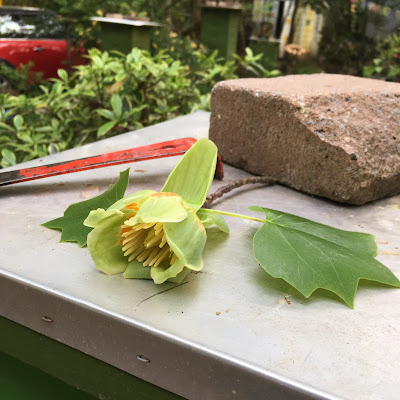This morning it's not clear whether I'm observing active scouting or a move-in at the hanging swarm trap. After a few more hours, I looked again and now convinced there's a move-in - see the large lump of bees attached to the bottom of the box that was not previously present. Tomorrow the forecast calls for rain - so, I'm glad they'll stay dry. This is my 2nd successful swarm trapping this spring.
This is my largest swarm ever, I always say that. In a few days, I'll transfer the frames and can really judge the size of this swarm.
This hanging 8-frame deep contains 1 frame of brood comb, 7 frames with foundation and a
swarm lure. A hole saw was used to create two entrances - one that you can see and another on the bottom side.
Hanging swarm trap advantages:
- no ladder climbing required with this rope hanging scheme
- large volume created by 8 deep frames
- movable frames can be transferred into other deep boxes without cutting comb
- bottom entrance encourages complete move-in and discourages comb building beneath the box
- sustainable alternative to splitting
Hanging swarm trap disadvantages:
- requires foundation as the swarm trap is not left-right level
The best element of the hanging swarm trap scheme is the safety of no ladder climbing. My next steps include using window screen and duct tape to cover the bottom entrance and to gradually move the trap to its final location. I'll move small distances every day or every other day to minimize bee entrance confusion.






